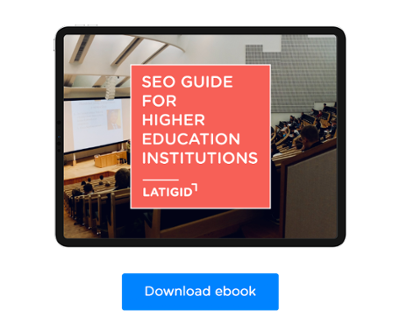
Lead generation, the process of identifying and cultivating potential students, plays a pivotal role in driving enrollment and enhancing the institution's overall reputation. However, despite its undeniable importance, many universities often find themselves struggling to effectively execute lead generation strategies.
In this blog article, we will explore seven common lead generation mistakes that universities frequently make, hindering their ability to connect with the right audience and convert prospects into enrolled students.
Neglecting Digital Presence
In today's technology-driven world, establishing a strong digital presence is no longer a luxury but a necessity for any organization, including universities. However, all too often, educational institutions overlook the significance of a robust online presence in their lead generation efforts, unwittingly depriving themselves of a vast pool of prospective students and missing out on numerous opportunities for growth and engagement.
The digital landscape offers universities an unparalleled platform to connect with potential students, showcase their unique offerings, and build meaningful relationships that can ultimately drive enrollment. Yet, several reasons contribute to the negligence of digital presence in the higher education sector.
Firstly, traditional marketing methods and word-of-mouth referrals have long been the staple for universities, making them hesitant to fully embrace digital strategies. Many institutions tend to rely on their established reputation and historic outreach methods, assuming that students will naturally gravitate towards them.
Secondly, budgetary constraints often play a role in this neglect. Building and maintaining a compelling online presence requires dedicated resources, time, and expertise. Some universities may be hesitant to invest in digital marketing, mistakenly viewing it as an optional expense rather than a strategic investment.
Furthermore, the lack of awareness or understanding of digital marketing's potential impact may cause universities to downplay its significance. This limited understanding can lead to underestimating the power of digital channels in reaching a broader audience and attracting prospective students from various demographics and geographic locations.
Unfortunately, overlooking digital presence can have detrimental consequences for a university's lead generation efforts. Prospective students, especially those from younger generations, are increasingly turning to the internet and social media to gather information about potential colleges and universities. If an institution fails to maintain an engaging and accessible online presence, it risks fading into the background amid the sea of competitors vying for students' attention.
Moreover, a weak or non-existent digital presence can perpetuate the perception of an outdated or unprogressive university, which may drive away tech-savvy students seeking modern and innovative educational experiences.
Related article: 5 Effective Lead Generation Strategies for Universities
Ignoring Social Media Platforms
Ignoring social media platforms is a significant and costly mistake that can hinder the growth and success of any organization, including universities. In today's digital age, social media has become a powerful tool for communication, engagement, and brand promotion. By neglecting these platforms, universities miss out on valuable opportunities to connect with their target audience, engage with potential students, and cultivate a strong online presence.
Missed Reach and Engagement
Social media platforms boast billions of active users worldwide, representing a vast audience of potential students. Ignoring these platforms means universities are missing out on reaching and engaging with a diverse and global pool of individuals interested in higher education. Social media provides an unparalleled opportunity for direct interaction and real-time communication, enabling universities to build relationships and foster engagement with prospective students.
Ineffective Brand Promotion
Social media is a powerful brand promotion tool. By actively participating on these platforms, universities can showcase their unique offerings, campus life, academic achievements, and research contributions. Neglecting social media means universities are failing to leverage a dynamic medium that can effectively build and strengthen their brand reputation, making it harder to stand out in the competitive landscape of higher education.
Lack of Community Building
Social media platforms facilitate the creation of vibrant online communities where current students, alumni, faculty, and prospective students can interact, share experiences, and contribute to the university's narrative. Ignoring these platforms means missing out on the opportunity to create a sense of belonging and loyalty among various stakeholders. Strong online communities can lead to increased word-of-mouth referrals and positive word-of-mouth marketing, essential for a university's growth and reputation.
Limited Insights and Feedback
Social media platforms provide valuable insights into the preferences, opinions, and expectations of the target audience. By ignoring these platforms, universities miss the chance to gather real-time feedback and sentiments from potential students. This feedback is essential for understanding their needs better, improving services, and tailoring marketing strategies to effectively attract and engage with the desired audience.
Being Outpaced by Competitors
In a highly competitive education landscape, universities that actively leverage social media have a competitive advantage. Institutions that ignore social media platforms may find themselves falling behind competitors who are adeptly utilizing these channels to connect with prospective students, showcase their strengths, and build lasting relationships.
Lack of Targeted Content
The lack of targeted content poses a significant challenge for universities aiming to attract and engage prospective students. One-size-fits-all approaches fall short in a competitive educational landscape, where personalized and relevant content is the key to capturing the attention of potential applicants. Understanding the importance of targeted content and implementing effective strategies to tailor messages is essential for universities seeking to optimize their marketing efforts and drive student interest.
Targeted content involves tailoring marketing messages and materials to cater specifically to the interests, preferences, and needs of distinct audience segments. Failing to produce such content can have several negative implications:
Diminished Engagement
Generic content lacks the personal touch that resonates with potential students. As a result, engagement levels may suffer, and the university's message might be overlooked or disregarded.
Reduced Relevance
A lack of targeted content can lead to a disconnect between the university's offerings and what prospective students are seeking in their educational journey. This disconnect can make the institution appear less relevant and appealing.
Lower Conversion Rates
Without personalized content, the chances of converting leads into inquiries and applications decrease. Tailored content is more likely to evoke a response and motivate potential students to take action.
Inefficient Resource Allocation
Investing resources in generic content that fails to connect with the target audience can be wasteful and yield suboptimal results. By understanding the importance of targeting, universities can allocate resources more efficiently and effectively.
Overlooking Mobile Optimization
In an era where mobile devices have become an integral part of daily life, overlooking mobile optimization can be a costly mistake for universities. With a significant portion of internet users accessing content through smartphones and tablets, failing to optimize websites and marketing efforts for mobile devices can lead to lost opportunities and decreased engagement with potential students. Understanding the importance of mobile optimization and implementing effective strategies is essential for universities seeking to stay relevant and competitive in the digital age.
Mobile optimization involves designing websites, emails, and other marketing content to provide an optimal user experience on various mobile devices. Ignoring mobile optimization can have serious consequences for universities:
Reduced User Experience
Websites that are not optimized for mobile devices often have slow loading times, awkward navigation, and difficulty in accessing information. This poor user experience can deter potential students from exploring further and prompt them to seek alternatives.
Missed Opportunities
With a growing number of users relying on mobile devices to access the internet, overlooking mobile optimization means missing out on a significant portion of the target audience. Failure to provide a seamless mobile experience can result in lost inquiries, applications, and potential enrollments.
Negative Brand Perception
Inadequate mobile optimization can reflect poorly on the university's image and reputation. Potential students may perceive the institution as outdated or unresponsive to modern technology trends, potentially affecting their perception of the overall educational quality.
Lengthy and Complicated Forms
Lengthy and complicated forms can act as a significant barrier in the lead generation process for universities. While forms are essential for collecting valuable information from potential students, asking for too much or presenting complex questions can deter prospects from completing the form and expressing interest in the institution. Understanding the negative impact of such forms and implementing user-friendly strategies can greatly improve the conversion rates and overall success of university lead generation efforts.
Lengthy and complicated forms can lead to several adverse outcomes for universities:
High Abandonment Rates
Potential students may feel overwhelmed or frustrated by a form that requires excessive information or is difficult to navigate. As a result, they may abandon the form midway, leading to lost leads and missed opportunities.
Poor User Experience
Lengthy forms can negatively impact the user experience, making it more likely for potential students to perceive the university as unresponsive to their needs and preferences.
Reduced Conversion Rates
The higher the number of form fields and complexity, the lower the chances of conversion. Simplifying the form can significantly improve the conversion rates and increase the number of inquiries and applications.
Missed Data Insights
Complicated forms may discourage potential students from providing accurate and complete information, limiting the university's ability to gather valuable insights about their target audience.
Related article: How to generate leads for Higher Education Institutions
Ineffective Call-to-Actions (CTAs)
A well-crafted CTA serves as a powerful prompt, encouraging potential students to take specific actions, such as filling out an inquiry form, downloading a brochure, or applying for admission. However, overlooking the importance of CTAs or employing ineffective ones can lead to missed opportunities and reduced conversion rates. Understanding the impact of CTAs and implementing strategies to create compelling and action-oriented CTAs is vital for universities seeking to boost their lead generation outcomes.
Ineffective CTAs can have significant repercussions for university lead generation efforts:
Low Conversion Rates
CTAs that lack clarity or fail to inspire action can result in low conversion rates. Potential students may hesitate to engage with the university further, impacting the number of inquiries and applications received.
Ambiguity and Confusion
Unclear or poorly worded CTAs can lead to confusion among potential students, making it challenging for them to understand what action they should take next. This lack of clarity can be discouraging and prompt users to abandon the process altogether.
Missed Opportunities
An ineffective CTA fails to capitalize on the interest and engagement potential students have shown in the university's content or offerings. Consequently, universities may miss out on valuable leads that could have been converted into enrolled students.
Failure to Nurture Leads
Lead nurturing involves building meaningful and personalized relationships with potential students throughout their decision-making journey. Neglecting this process can lead to several negative outcomes:
Fading Interest
Without consistent communication and engagement, potential students may lose interest in the university and seek other options that actively engage with them.
Reduced Conversions
Failure to nurture leads can result in missed opportunities to guide potential students through the enrollment process, leading to lower conversion rates.
Lost Engagement
Prospective students who feel ignored or undervalued may disengage from the university's marketing efforts, making it challenging to re-engage them later.
Related article: How Lead Generation Drives Growth for Universities
About LATIGID
We are a Higher Education Marketing Agency, specializing in Inbound Marketing. We help you grow by increasing website traffic, generating more student leads, and closing those leads into enrollment. With a deep understanding of the latest industry trends and best practices, we are well equipped to help your institution grow.
If you are looking for a Higher Education Marketing Agency to partner with, check our page to see what we can do for you!
Download our SEO guide and learn how to build a strategy to optimize your Higher Education Institution's website





